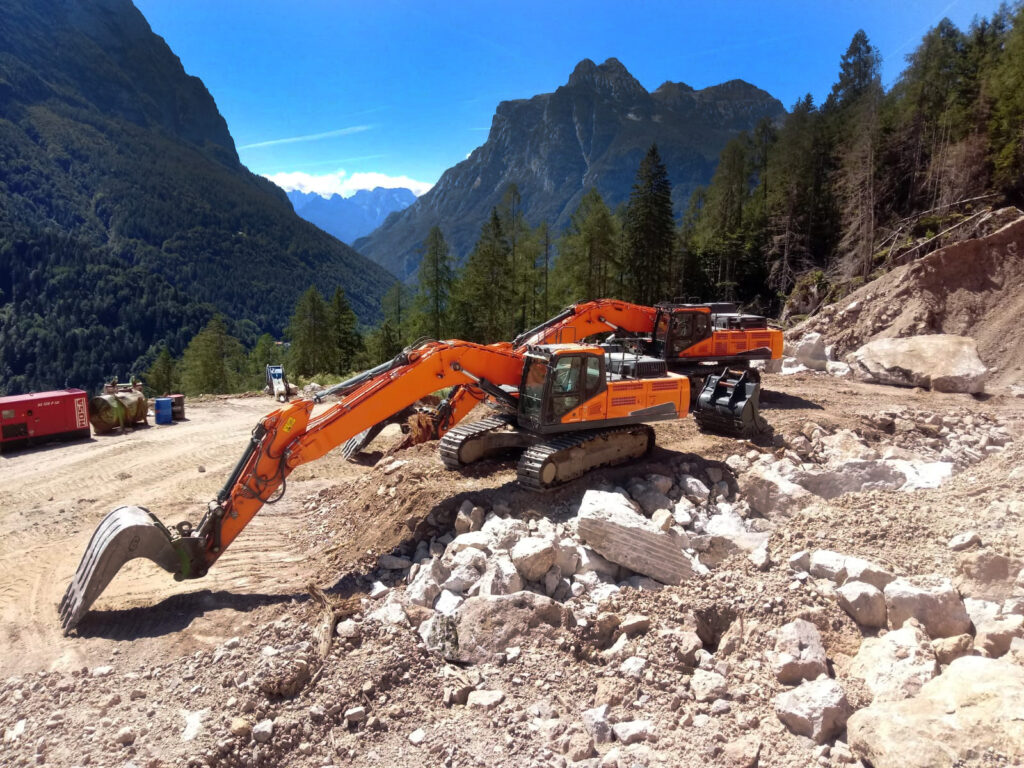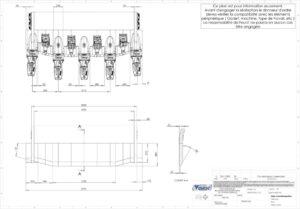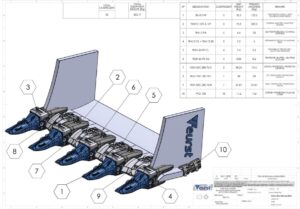The chronicle of ground engaging tools: zoom on aggregate extraction
Focus on the first resource of the subsoil exploited in France, the aggregate, a material essential to our daily life…!

- 22 July 2022
Comment avez-vous trouvé cet article ?
Already used in ancient times, aggregates are still the best solution for most public works, civil engineering and construction projects. Most of them are used in the construction of pavements and concrete.
In this first chronicle of ground attack solutions, we will focus on the extraction process of aggregates and detail their characteristics. Focus on the first resource of the subsoil exploited in France, the aggregate, a material essential to our daily life…!
What are aggregates?
Also known as aggregate, aggregates are rock fragments of varying sizes. Indeed, according to its size, the aggregate can be classified in one of the following categories:
- Sands
- Sand
- Gravel
- Bank Gravel
- Ballast
Moreover, aggregates are classified in different families which have different geological characteristics
Firstly, alluvial aggregates. They are exploited mainly in the bottom of valleys. These aggregates come from thousands of years of erosion of the reliefs which were transported in the rivers, torrents or which were in contact with the glaciers. The alluvial aggregates are particularly identifiable by their rounded shape. These aggregates are called “rolled” aggregates. Indeed, the wear that they have naturally undergone in the rivers gives them a rounded shape, making them an ideal material for concrete compaction.
Depending on the region of extraction, we can find different rocks but the majority of aggregates used for concrete are siliceous rocks, limestone or silico-limestone.
Then, the aggregates from massive rocks. They can be from volcanic rocks such as basalt or rhyolite. They can also be made of plutonic rocks such as granite, diorite, or sedimentary rocks (limestone, sandstone, …), and metamorphic rocks (gneiss, amphibolite, …).
Massive rock aggregates are mined using explosives, and mechanical treatment allowing their fragmentation to obtain the desired granulometry.
They undergo a mechanical transformation as the process of crushing, grinding, screening and washing.
Finally, the last family of aggregates is the so-called recycling and artificial aggregates (recycled concrete and asphalt, blast furnace slag, …). The recycling aggregates are aggregates resulting from a mechanical treatment after deconstruction / demolition of existing infrastructures. 10% of the aggregates used come from recycling.
Aggregate extraction
The extraction of aggregates varies according to their type.
 If the aggregate is said to be alluvial, then it comes from an alluvial deposit. According to its situation, the extraction can be done in water or out of water.
If the aggregate is said to be alluvial, then it comes from an alluvial deposit. According to its situation, the extraction can be done in water or out of water.
In the case of a terrestrial deposit, the extraction is carried out with traditional machines such as excavators or loaders equipped with a large bucket. If the aggregate comes from massive rocks, the use of explosives will allow its loading and its treatment in crushed aggregates.
Concerning the types of extraction, there are different ways to extract aggregates.
The traditional method consists in making a multiple drilling on the front of defined size, inserting explosive charges, blasting the front and then come to recover the crude to take it to the crushers. The collection is done with the help of excavators and/or loaders that attack and load the crushed material into dumpers.
In cases where the extracted material is soft, the machines attack the face without blasting.
The last method is the technique known as the scree, often used in the quarries of the Maurienne Valley, where the sediments are extracted by digging from the bottom of the face and the materials fall by themselves by gravity.
Bucket equipment for aggregate extraction
 Concerning the equipment of a production bucket, Feurst® technical services have developed a general prescription tool available on the website, allowing you to have a recommendation of your bucket.
Concerning the equipment of a production bucket, Feurst® technical services have developed a general prescription tool available on the website, allowing you to have a recommendation of your bucket.
Nevertheless, we can design with the help of the customer a “custom” bucket in order to have a high performance ground engaging tool.
In this case, one of our experts will contact the customer (possibility of moving on site) and he will study the way of working, the conditions of extractions which are specific to each quarry (granulometry, type of rock, etc…).
After having collected all the information and taken all the measurements of the bucket blade (length with sides, length “overall”, depth, thickness of the blade, shape of the blade (straight, semi-delta, see delta), thickness of the sides; our expert is able to draw a plan of the bucket blade with all the necessary recommendations and recommendations: positioning of the adapters, inter-axis of the adapters in order to accommodate inter-tooth shields adapted to the inter-axis to protect the blade in hard and abrasive conditions.
 We will also advise you on the shape of the tooth best suited to your extraction conditions, depending on the material being extracted. It is obvious that a reinforced tooth shape to work in abrasive materials such as granite or diorite will be prescribed rather than an “impact” shape working in sedimentary materials.
We will also advise you on the shape of the tooth best suited to your extraction conditions, depending on the material being extracted. It is obvious that a reinforced tooth shape to work in abrasive materials such as granite or diorite will be prescribed rather than an “impact” shape working in sedimentary materials.
The final goal is to offer the customer a specific recommendation adapted to the working methods in order to provide a very interesting compromise between resistance to abrasion, increased penetration in the materials; to push back the wear ratios as far as possible and above all to offer a solution of comfort as well at the level of the driver as of the machine which, if it is badly equipped, can be damaged on the long term of the structural parts and increase the levels of consumption in fuel.
Aggregates exploitation
Aggregates are indispensable materials. Indeed, to meet the needs of the French economy alone, no less than 1 million tons of aggregates must be produced every day.
80% of this production is destined for civil engineering and 20% for construction. Among its most common uses, we can mention :
Construction
Aggregate is used to make concrete. The concrete is thus a reconstituted stone, composed of rock fragments. Its resistance and longevity make concrete the most used element in the construction sector. It allows the construction of buildings such as houses, buildings, hospitals, bridges etc.
Roads and pavements
Aggregate provides adhesion and stability to roads and pavements. It is used for both foundations and wearing courses such as asphalt.
Railroads
Aggregate is used to maintain rail gauge while providing excellent rigidity, supporting the passage of trains and high-speed trains.
Some key figures
- The construction of a house = 100 to 300 t of aggregates
- 1 km of railroad track = 10,000 to 15,000 t of ballast,
- A high school or a hospital = 5,000 to 20,000 tons of aggregates
- 1 km of highway = 20,000 to 30,000 t of aggregates
In conclusion, aggregates are an indispensable resource. It allows the construction of pavements, roads, public squares, sidewalks, railroads, but also buildings such as houses, offices, factories, schools, hospitals…
The characteristics of the different aggregates and the requirements of the customers vary according to the use. Density, angularity, size, granularity are elements that are differentiating.
Head Office
1 Boulevard de la Boissonnette
F-42110 Feurs – France
+33 4 77 27 40 63
sales@safe-feurst.fr